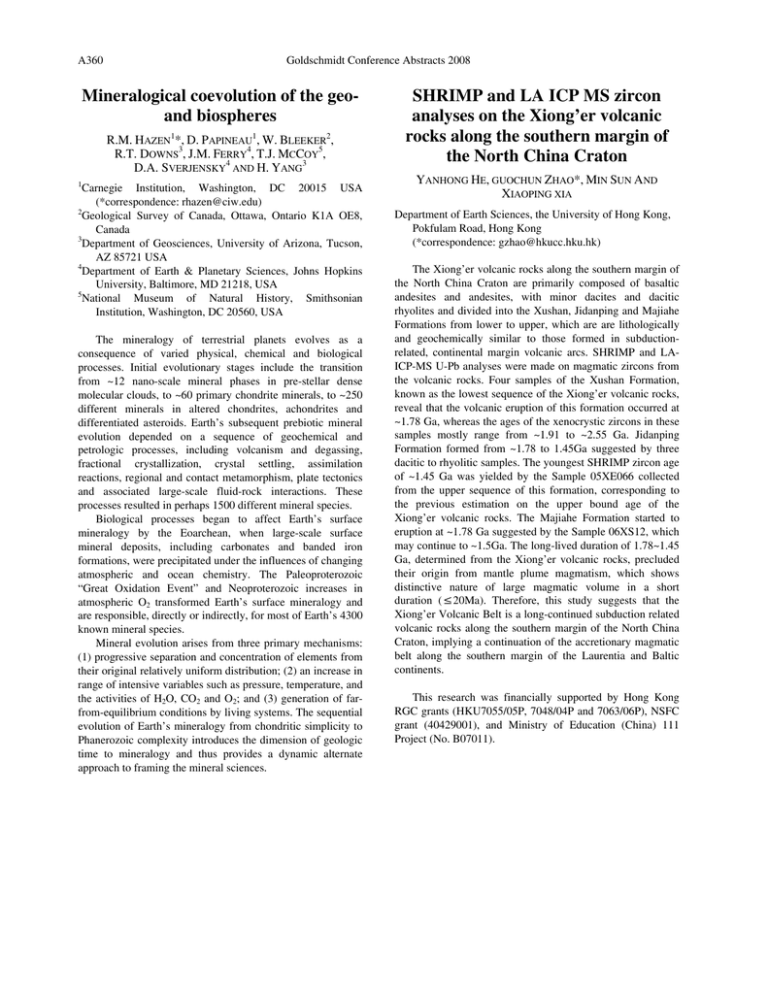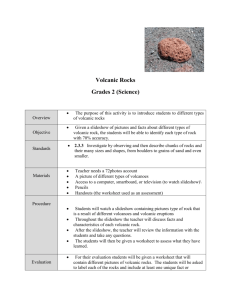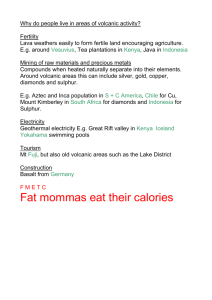Mineralogical coevolution of the geo- and biospheres R.M. H
advertisement

A360 Goldschmidt Conference Abstracts 2008 Mineralogical coevolution of the geoand biospheres R.M. HAZEN1*, D. PAPINEAU1, W. BLEEKER2, R.T. DOWNS3, J.M. FERRY4, T.J. MCCOY5, D.A. SVERJENSKY4 AND H. YANG3 1 Carnegie Institution, Washington, DC 20015 USA (*correspondence: rhazen@ciw.edu) 2 Geological Survey of Canada, Ottawa, Ontario K1A OE8, Canada 3 Department of Geosciences, University of Arizona, Tucson, AZ 85721 USA 4 Department of Earth & Planetary Sciences, Johns Hopkins University, Baltimore, MD 21218, USA 5 National Museum of Natural History, Smithsonian Institution, Washington, DC 20560, USA The mineralogy of terrestrial planets evolves as a consequence of varied physical, chemical and biological processes. Initial evolutionary stages include the transition from ~12 nano-scale mineral phases in pre-stellar dense molecular clouds, to ~60 primary chondrite minerals, to ~250 different minerals in altered chondrites, achondrites and differentiated asteroids. Earth’s subsequent prebiotic mineral evolution depended on a sequence of geochemical and petrologic processes, including volcanism and degassing, fractional crystallization, crystal settling, assimilation reactions, regional and contact metamorphism, plate tectonics and associated large-scale fluid-rock interactions. These processes resulted in perhaps 1500 different mineral species. Biological processes began to affect Earth’s surface mineralogy by the Eoarchean, when large-scale surface mineral deposits, including carbonates and banded iron formations, were precipitated under the influences of changing atmospheric and ocean chemistry. The Paleoproterozoic “Great Oxidation Event” and Neoproterozoic increases in atmospheric O2 transformed Earth’s surface mineralogy and are responsible, directly or indirectly, for most of Earth’s 4300 known mineral species. Mineral evolution arises from three primary mechanisms: (1) progressive separation and concentration of elements from their original relatively uniform distribution; (2) an increase in range of intensive variables such as pressure, temperature, and the activities of H2O, CO2 and O2; and (3) generation of farfrom-equilibrium conditions by living systems. The sequential evolution of Earth’s mineralogy from chondritic simplicity to Phanerozoic complexity introduces the dimension of geologic time to mineralogy and thus provides a dynamic alternate approach to framing the mineral sciences. SHRIMP and LA ICP MS zircon analyses on the Xiong’er volcanic rocks along the southern margin of the North China Craton YANHONG HE, GUOCHUN ZHAO*, MIN SUN AND XIAOPING XIA Department of Earth Sciences, the University of Hong Kong, Pokfulam Road, Hong Kong (*correspondence: gzhao@hkucc.hku.hk) The Xiong’er volcanic rocks along the southern margin of the North China Craton are primarily composed of basaltic andesites and andesites, with minor dacites and dacitic rhyolites and divided into the Xushan, Jidanping and Majiahe Formations from lower to upper, which are are lithologically and geochemically similar to those formed in subductionrelated, continental margin volcanic arcs. SHRIMP and LAICP-MS U-Pb analyses were made on magmatic zircons from the volcanic rocks. Four samples of the Xushan Formation, known as the lowest sequence of the Xiong’er volcanic rocks, reveal that the volcanic eruption of this formation occurred at ~1.78 Ga, whereas the ages of the xenocrystic zircons in these samples mostly range from ~1.91 to ~2.55 Ga. Jidanping Formation formed from ~1.78 to 1.45Ga suggested by three dacitic to rhyolitic samples. The youngest SHRIMP zircon age of ~1.45 Ga was yielded by the Sample 05XE066 collected from the upper sequence of this formation, corresponding to the previous estimation on the upper bound age of the Xiong’er volcanic rocks. The Majiahe Formation started to eruption at ~1.78 Ga suggested by the Sample 06XS12, which may continue to ~1.5Ga. The long-lived duration of 1.78~1.45 Ga, determined from the Xiong’er volcanic rocks, precluded their origin from mantle plume magmatism, which shows distinctive nature of large magmatic volume in a short duration (≤20Ma). Therefore, this study suggests that the Xiong’er Volcanic Belt is a long-continued subduction related volcanic rocks along the southern margin of the North China Craton, implying a continuation of the accretionary magmatic belt along the southern margin of the Laurentia and Baltic continents. This research was financially supported by Hong Kong RGC grants (HKU7055/05P, 7048/04P and 7063/06P), NSFC grant (40429001), and Ministry of Education (China) 111 Project (No. B07011).







